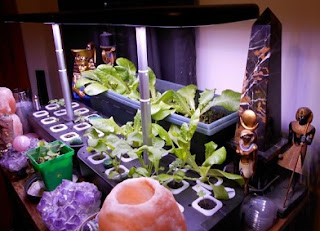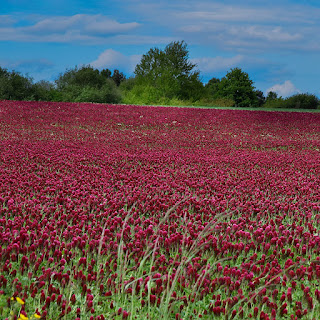Unless you live in a tropical environment or close to a southern coastline somewhere (like Zones 8, 9, or 10), you more than likely have certain growing seasons in your area along with winter months where your garden tools collect dust in anticipation of Spring. For some of you, it's the same type of anticipation during that time period, year after year, always waiting for the weather to warm up so you can get your garden started.
I'm sure, because of this, that many of you have also planted stuff too early in the season before, only to have a frost come by and kill your plants, as well. This year, however, I did prolong things by having a Fall crop. After my summer garden was over, I plowed it all up, waited for the weather to cool, then planted some of the fastest growing cool weather crops: turnip greens and radishes. I must say, though, cool-season vegetables are limited, as for variety, in what you can grow; a lot of folks may not like those options.
But have you ever thought about growing some of your edibles indoors? I know the technology has been around for a long while, but it has come a long way when concerning the mini hydroponics that you use for growing plants indoors. There are full-sized versions out there, too, albeit a bit too pricey for my liking. On this post, I'm talking about the mini, more compact versions of hydroponics along with some of the fastest growing plants that I've experimented with so far. Yeah, this is a Nature & Wildlife Blog, but that doesn't mean that the subjects are limited to outdoors, does it?
Anyway, I've recently purchased 2 indoor growing systems that use the modern LED lighting technology. To clarify, they would be better described as mini hydroponics. Why did I start out with 2? Well, I had an idea, which I will get to that in a few minutes. But first, I want to quickly cover the fastest growing plants I've encountered thus far while using this system. This list will be fairly small since I've only experimented with a few plants, but I have loads of seeds for a bunch of different plants, herbs, etc. It just takes time to let each one go through its growing cycle before you harvest and try different species next and so on. So far, I've found all the seeds I need for hydroponics from Amazon.com and Urban Farmer (www.ufseeds.com).
When it comes to lettuce, loose-leaf lettuce is by far the better choice as opposed to head lettuce for these mini, indoor setups. It really just doesn't appear to have enough room for big heads of lettuce. The leaf lettuce, though, you can pick the outer leaves as you need them and they just keep growing and growing. The highest quality lettuce I have tried thus far is the buttercrunch variety. It's a good thing this has been the fastest growing lettuce, because it has a nice buttery taste and a smooth texture that beckons for a variety of culinary uses.
Next up is Arugula, which a lot of folks may have not ever tried. It adds a nice peppery or mustard-like flavor to salads and/or whatever else you like to use it on. This is one of the plants I have did a side-by-side comparison under the same lighting conditions, as a "soil vs. hydroponics" test. I must say, arugula appeared to have grown twice as fast using my mini indoor growing system when compared to traditional dirt mixtures.
I would not normally try to grow tomatoes in one of these mini indoor systems using hydroponics, but I did find one variety that was perfect for this, which was the Tiny Tim Tomato. It's small, compact size with high yields is the perfect choice for these particular systems. Since this is a recent experiment, I can only gauge it by the first couple of inches of growth. However, I must say, it has been the fastest sprouting and growing tomato I have seen, as they normally start off really slow when using soil and normal growing elements outside.
This next one is well known for being one of the fastest plants for hydro growing platforms, and that is watercress. This is the only one I mentioned so far that I haven't tried yet, but thought I'd mention it anyway. For contrast, the slowest growing plants I've tried thus far in these water systems has been chives and bunching onion. I'm not saying they were ridiculously sluggish, but just slow compared to the others I've tested.
Well, I saved the fastest (out of what I've tried) for last. The Hong Vit radish is well known in the microgreen industry. They germinate and shoot up really quick, even under various conditions. I've seen experiments online where they compared hydroponics to soil while growing these. They used fertilizer in one water-based system and no nutrients in the other and the same for the soil - one using fertile, rich soil and one with poor soil quality. It seems that the Hong Vit grows fast in any of those conditions, but they thrived the most in hydroponics. Oh, by the way, this is not the type of radish that grows a root vegetable; it is used for the greens, stems, and sprouts. One interesting thing to note, is that the Hong Vit, when young, appears to have a spicier taste when grown in poor conditions. I didn't use it for microgreens, but I picked mine in the semi-early stages; I guess you could call it baby Hong Vit. On a side note, they are really attractive and add some color to your growing area. They have a purplish to pinkish stem leading up to the green foliage. I've harvested a few rounds of this so far from my indoor setup, and they were all good albeit milder than I wanted them to be! I must have used too much fertilizer; ha!
Now that we have touched on the subject of microgreens, I suppose that these mini kits for indoor hydroponics would be suitable for those. I must say, though, I think a person would be (if you are into the sprouts / microgreens thing) better off buying separate growing lights and just use those 1.5-inch Rockwool/Stonewool Grow Cubes Starter Sheets inside of large pans, sort of like baking trays, to use for microgreens inside your home. Of course, there are many different types of growing mediums to use in those water-based tray systems, but no matter what, growing microgreens is about as easy as it gets. How can you screw-up while harvesting sprouts?
As for fertilizing your mini hydroponics system, the product I purchased came with 2 bottles that you mix with water. Since I bought 2 of them, I have 4 bottles of fertilizer so I should be good for quite a while. The setup I have come with Plant Food A and Plant Food B. Bottle A contains 9% N, 8% P2O5, 30% K2O, 3% Mg, .30% Iron, .06% Manganese, .005% Copper, .01% Zinc, and .1% Boron. Plant Food B contains 11.5% N (nitrogen), and 26% Calcium. Of course, you can purchase any type of fertilizer you want but, whatever you do, make sure it is formulated for hydroponics. Don't go dumping Miracle Grow into your indoor growing system. Trust me, I've read about some of those stories and, uh, those people didn't harvest very much to say the least. Don't get me wrong, Miracle Grow seems to work great when using in soil, but it is not recommended for these types of hydro growing systems. I know you're in a hurry to get those indoor crops, but try to calm down a bit; ha!
Oh, before I go, let me get back to explaining why I bought two of these indoor kits. It was a simple idea, really, which was to borrow the light from them! You see, if you have the room, setting up two of these systems side-by-side emits a good bit of light. So, I just stuck a long container filled with soil behind these, so I could grow even more stuff. You could also put plants in front of these, as well. Hey, I wanted to get more bang for my money, and this stuff works! I've really enjoyed this Mini Hydroponics thing thus far. Oh, to show what I'm talking about when it comes to borrowing light, I took a couple of pics a few moments ago. Please note, I just recently harvested most of the plants so it looks a little bare at the moment, but it won't be long before they are full again. The container with soil behind them is the ones I'm just going to let grow for a while before I harvest. I actually transplanted them from the water-based system when they were just little sprouts.
To show how fast these plants grow, this next photo is just 12 days later, after I took those other two, up above. Plus, I already picked some lettuce from there earlier that week. Ignore the little green pot, as I recently replanted some Hong Vit in there. Anyway, check out this progress after only 12 days:
One final thought about this: Even though I haven't used it for this yet, I can already see a huge advantage I'm going to have next year when starting my real garden outside. Certain plants just always seem to work better when transplanted, like peppers and tomatoes, for example. Well, next year I will harvest everything from this growing system at the end of winter and start all of my seedlings indoors, then transplant them into my outdoor growing spots after the last frost. Then, I will go back to growing random stuff indoors, as well. Man, this mini hydroponics thing is going to really work out nicely. Yeah, maybe I'll have the fastest growing garden plants next year as well; uh, I mean, hopefully. You never know about the weather anymore, so I won't get too cocky about it; ha!
Pictured below is the model I currently own. It is called the Ailess Pro, but there are many more models than that to pick from. Some larger, some smaller; some cheaper, some more expensive, etc.
Image Credits: 1st & 5th image are Product Images - Fair Use; 2nd, 3rd & 4th images are my own photos - if you'd like to use them for something online, please provide a link back to this blog for credit; thanks!
Semi-related Links:
*Crimson Clover - Benefits & Reasons for Cover Crops
---End of Post "Fastest Growing Plants for Indoor Mini Hydroponics"




















